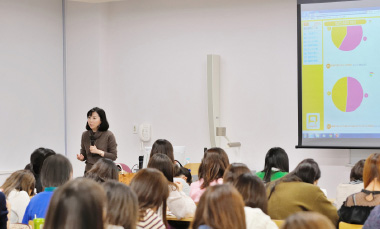

Komaya Seminar Motto: Enjoy your research!
Students spend two years studying a topic
they are really interested in and write a graduation thesis.
Komaya Seminar Goal
Through the seminar and individual research, students will gain media and information literacy,
the ability to autonomously and critically evaluate media content and to thrive in a highly informationalized society.
Komaya Seminar Flow
Juniors: training on how to look at individual research from both broad and narrow perspectives
Spring Semester
Students think carefully about the appropriateness of the topics they are really interested in as media research projects.
Students ask themselves questions such as “How is this related to media?” and “Is this boom influenced by media?
” They organize their ideas using brainstorming techniques such as the KJ method.
Next, students search the library and databases for texts related to their topics, read the texts, examine the texts critically in group discussions,
and write up critical analyses. At the end of the semester, students narrow down their thesis topics and present those topics for review.
Fall Semester
Students learn various research methods, including literature review, interviews, surveys, projects, and workshops, and then create a research plan that includes research methods appropriate for their own research topic. Students build a collection of research, gather qualitative and quantitative data, and analyze data using software. At the end of the semester, students formally report on the progress of their research.
Seniors: training on how to take both an experiential and systematic as well as critical approach to the thesis writing process
Spring semester
Students polish the content of their portfolios (reflection sheets, critical analyses, research plan, data collection plans, data analysis, etc. that have been managed online), and construct the foundation of their theses, while simultaneously engaged in job hunting.
Fall semester
 Students complete outlines, and ultimately their theses, as they receive individualized editing instruction on drafts. After submitting their theses, students work on a PowerPoint presentation of their research results to be presented formally.
Students complete outlines, and ultimately their theses, as they receive individualized editing instruction on drafts. After submitting their theses, students work on a PowerPoint presentation of their research results to be presented formally.

実践女子大学 駒ゼミ2期生 (2018年度)
• GLAYのHISASHI氏における音楽性の一考察
• 戦争プロパガンダと映画の功罪
• ジャニーズファンにおける意識行動研究
• 劇団四季『アラジン』における一考察
• 恋愛ドラマの変遷について
• 「女子力」とは~私たちが今身につけるべきチカラ~
• リトルツインスターズ「キキララ」における長寿キャラクターの一考察
• 菓子のパラダイムシフトとしての「スウィーツ」~パンケーキを中心に~
• 『おそ松さん』に関する―考察~クズでニートな6つ子が愛される理由~
• 韓国の恋愛ドラマにおける一考察
• 「キャラクターコスメ」の購買意欲と行動に関する一考察~女性はキャラコスに何を夢見るか~
実践女子大学 駒ゼミ1期生 (2017年度/退官された前任の先生から引き継ぎ)
• 保育士の視点から考える待機児童問題
• “民主主義国家”アメリカの古今東西
• ディズニーランドのホスピタリティにおける一考察
• 青年期の喫煙における一考察~マイノリティーでも吸う理由~
• 農業の衰退は止められるか~千葉県「柏市都市活性化農業計画」の試み~
• Jリーグと地方創生における一考察~清水エスパルスと清水市の関係性から~
• 現代女性の労働環境について~職種選択にみる女性の働き方~
昭和女子大学 駒ゼミ8期生 (2016年度)
• 子どもとおもちゃの関係性~抱き人形『ぽぽちゃん』を中心に~
• 『はらぺこあおむし』のミライ〜紙の絵本とデジタルアプリの比較を通して〜
昭和女子大学 駒ゼミ7期生(2014年度)
• 子どもに人気なサンリオキャラクターに関する一考察~商品から見るハローキティ・マイメロディから
ジュエルペット・ぼんぼんりぼんまでのキャラクター比較~
• 『アンパンマン』におけるキャラクター「ばいきんまん」の一考察
• “イケメン”にみる女子大生の嗜好観
• ディズニー映画『ピノキオ』におけるキャラクター研究~ランプウィックの存在意義~
• 幼児期女児の想像性における一考察~『ディズニープリンセス』が拓くファンタジーの世界~
• 幼児と特撮ヒーローに関する一考察~幼児期男児のヒーローごっこ遊びを通して~
昭和女子大学 駒ゼミ6期生(2013年度)
• 外国語活動における授業研究~教科を活用した小学校英語教育の可能性~
• 幼児の‘想像性’と‘創造性’に関する一考察― 絵本の続きを考える ―
昭和女子大学 駒ゼミ5期生(2012年度)
• 映画『クレヨンしんちゃん』におけるジェンダー研究―映画に登場した社会的性表現に関わる描写から―
• ドラえもんとのび太の関係性 ― 映画『ドラえもん のび太とブリキの迷宮』を通して ―
• 幼児を対象とした子ども雑誌の有効性―子ども雑誌『幼稚園』を中心に―
• 殺人事件が登場しない『名探偵コナン』の教育的魅力について
昭和女子大学 駒ゼミ4期生(2011年度)
• 幼児期の夢の実現性における一考察―大学生の進路選択は、子どもの頃の夢と関連はあるか―
• 子どもにとっての“良い”絵本とは?― Bookstart 選定絵本の読み聞かせ場面における日英比較 ―
• 児童とマンガの関わりについての一考察~『ONE PIECE』を中心に小学生・保護者・大学生の比較~
昭和女子大学 駒ゼミ3期生(2010年度)
• 幼児向けテレビアニメとごっこ遊びとの関係性―女児のプリキュアごっこを通して―
昭和女子大学 駒ゼミ2期生(2009年度)
• 情報モラル教育における授業研究~ケータイ教材を活用した授業~
• 新聞教育がもたらす教育的効果に関する研究~学級新聞の制作過程における児童の言語活動に着目して~
• 幼小連携における幼児と児童の交流活動 ―「なめらかな接続」への一考察―
昭和女子大学 駒ゼミ1期生(2007年度)
• 国語科におけるメディア単元の実践研究
• キャッチボール型言語コミュニケーション能力の形成―小学校低学年における「話すこと・聴くこと」の関係性に着目して―

copyright(c) 2019,KOMAYA Media Lab. All rights reserved.






